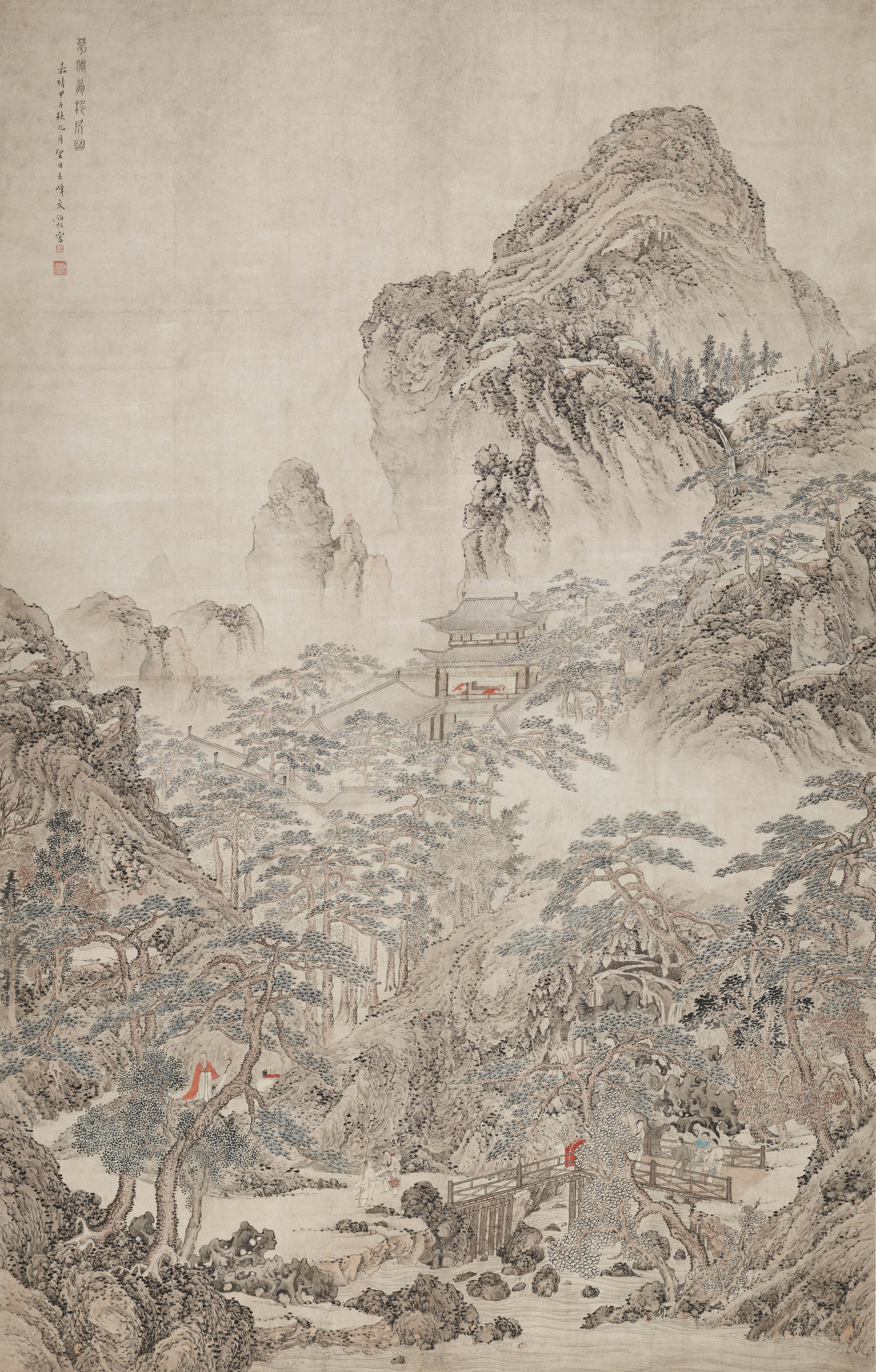文伯仁《葛稚川移居圖》

葛僊翁移居圖,嘉靖甲子(1564)秋九月望日,五峰文伯仁寫。
鈐印:伯仁
賞析
Ge Hong Moving Residences was painted in the autumn of 1564 by the Wu School painter and Suzhou-native Wen Boren (ca. 1502–1575). Wen Boren's attention to detail and refined brushwork make this painting stand out as a masterpiece. Despite the flush vegetation and large pine trees that seem to crowd the pictorial space, the composition is in fact clear and well-structured. Viewers can follow Ge Hong (283–343), clad in red and accompanied by a crane in the left lower part of the painting, on his journey along a S-curved path to a temple hidden among the mountains. The legendary Daoist and proponent of life-prolonging alchemy is accompanied by servants carrying utensils and ingredients meant to help him in his experiments and rituals. For example, two servants to the right carry a cooking vessel with the help of a pole. Another servant, having already crossed the bridge, shoulders a bunch of scrolls on which Ge Hong may have written his most famous work, the Baopuzi, in which he discussed techniques to become an immortal – the lingzhi mushrooms contained in the basket that the servant also carries are certainly meant to be used in cooking potions for that purpose.
All these details are carefully depicted by Wen Boren with a very fine brush and masterfully applied lines. The finesse of these lines used for architecture and humans sits in contrast to the more energetic brushwork that Wen used to paint the natural environment, in particular the mountains. Wen Boren's brushwork is stylistically derived from the Yuan dynasty (1279–1368) painter Wang Meng (ca. 1308–1385) and thus shows how well-trained the painter was. But Wen did not use this brush manner only to demonstrate his art historical knowledgeable – rather, the energetic, fine, and whirling texture strokes and ink dots evocative of vegetation lend the landscape an air of transformative energy. Wen Boren in fact alludes to the access to an afterworld by depicting the entrance to a Daoist grotto at the top of the monumental mountain. The landscape's implied capacities thus befit the topic of a human trying to attain metamorphosis as an immortal. The beauty of the work then lies in the contrast between the worldly spaces of humans, depicted in controlled brushwork, and the spheres of an afterlife-to-be-attained that Wen Boren depicts with transformative brushwork.
《葛稚川移居圖》是吳門畫家、蘇州人文伯仁(約1502-1575年)於1564年秋所繪。文伯仁對細節的關注和精緻的筆觸使這幅畫作為一幅傑作脫穎而出。雖然茂密的植被和大松樹似乎擠滿了畫面空間,但實際上構圖清晰,結構合理。觀眾可以跟隨葛洪(283-343)的腳步,他身穿紅衣,在畫的左下方有一隻仙鶴相伴,沿著一條S型曲線的小路前往隱藏在山間的道觀。這位傳奇的道家和延年益壽的煉丹術的倡導者由僕人陪同,他們攜帶的器具和材料是為了幫助他進行實驗(煉丹)和儀式。例如,右邊的兩個僕人用一根桿子抬著一個炊具。另一個僕人已經過了橋,肩上扛著一束捲軸,葛洪可能在上面寫了他最著名的作品《抱朴子》,他在其中討論了成仙的技巧,這個僕人還帶著籃子里的靈芝,應該是用來為熬煮湯藥。
所有這些細節都是文伯仁用非常精細的畫筆和巧妙的線條精心描繪的。這些用於建築和人物的精細線條與文伯仁用於描繪自然環境,特別是山巒的更有活力的筆觸形成了對比。文伯仁的筆法在風格上源於元代(1279-1368)畫家王蒙(約1308-1385),因此顯示了畫家的訓練有素。但文伯仁使用這種筆法並不只是為了展示他的藝術史知識,相反,充滿活力、精細、旋轉的紋理筆觸和令人聯想到植被的墨點使風景有了一種變革的能量。事實上,文伯仁通過描繪山頂的道教石窟入口,暗示了通往後世的通道。因此,景觀的隱含能力與人類試圖實現蛻變為神仙的主題相稱。這幅作品的魅力在於,文伯仁用受控的筆觸描繪了人類的世俗空間,而用變革性的筆觸描繪了即將實現的後世的領域,兩者之間形成了對比。
Henning von Mirbach, Research assistant, HCS Calligraphy Arts Foundation
米翰寧 何創時書法基金會 副研究員
Ge Hong Moving Residences was painted in the autumn of 1564 by the Wu School painter and Suzhou-native Wen Boren (ca. 1502–1575). Wen Boren's attention to detail and refined brushwork make this painting stand out as a masterpiece. Despite the flush vegetation and large pine trees that seem to crowd the pictorial space, the composition is in fact clear and well-structured. Viewers can follow Ge Hong (283–343), clad in red and accompanied by a crane in the left lower part of the painting, on his journey along a S-curved path to a temple hidden among the mountains. The legendary Daoist and proponent of life-prolonging alchemy is accompanied by servants carrying utensils and ingredients meant to help him in his experiments and rituals. For example, two servants to the right carry a cooking vessel with the help of a pole. Another servant, having already crossed the bridge, shoulders a bunch of scrolls on which Ge Hong may have written his most famous work, the Baopuzi, in which he discussed techniques to become an immortal – the lingzhi mushrooms contained in the basket that the servant also carries are certainly meant to be used in cooking potions for that purpose.
All these details are carefully depicted by Wen Boren with a very fine brush and masterfully applied lines. The finesse of these lines used for architecture and humans sits in contrast to the more energetic brushwork that Wen used to paint the natural environment, in particular the mountains. Wen Boren's brushwork is stylistically derived from the Yuan dynasty (1279–1368) painter Wang Meng (ca. 1308–1385) and thus shows how well-trained the painter was. But Wen did not use this brush manner only to demonstrate his art historical knowledgeable – rather, the energetic, fine, and whirling texture strokes and ink dots evocative of vegetation lend the landscape an air of transformative energy. Wen Boren in fact alludes to the access to an afterworld by depicting the entrance to a Daoist grotto at the top of the monumental mountain. The landscape's implied capacities thus befit the topic of a human trying to attain metamorphosis as an immortal. The beauty of the work then lies in the contrast between the worldly spaces of humans, depicted in controlled brushwork, and the spheres of an afterlife-to-be-attained that Wen Boren depicts with transformative brushwork.
《葛稚川移居圖》是吳門畫家、蘇州人文伯仁(約1502-1575年)於1564年秋所繪。文伯仁對細節的關注和精緻的筆觸使這幅畫作為一幅傑作脫穎而出。雖然茂密的植被和大松樹似乎擠滿了畫面空間,但實際上構圖清晰,結構合理。觀眾可以跟隨葛洪(283-343)的腳步,他身穿紅衣,在畫的左下方有一隻仙鶴相伴,沿著一條S型曲線的小路前往隱藏在山間的道觀。這位傳奇的道家和延年益壽的煉丹術的倡導者由僕人陪同,他們攜帶的器具和材料是為了幫助他進行實驗(煉丹)和儀式。例如,右邊的兩個僕人用一根桿子抬著一個炊具。另一個僕人已經過了橋,肩上扛著一束捲軸,葛洪可能在上面寫了他最著名的作品《抱朴子》,他在其中討論了成仙的技巧,這個僕人還帶著籃子里的靈芝,應該是用來為熬煮湯藥。
所有這些細節都是文伯仁用非常精細的畫筆和巧妙的線條精心描繪的。這些用於建築和人物的精細線條與文伯仁用於描繪自然環境,特別是山巒的更有活力的筆觸形成了對比。文伯仁的筆法在風格上源於元代(1279-1368)畫家王蒙(約1308-1385),因此顯示了畫家的訓練有素。但文伯仁使用這種筆法並不只是為了展示他的藝術史知識,相反,充滿活力、精細、旋轉的紋理筆觸和令人聯想到植被的墨點使風景有了一種變革的能量。事實上,文伯仁通過描繪山頂的道教石窟入口,暗示了通往後世的通道。因此,景觀的隱含能力與人類試圖實現蛻變為神仙的主題相稱。這幅作品的魅力在於,文伯仁用受控的筆觸描繪了人類的世俗空間,而用變革性的筆觸描繪了即將實現的後世的領域,兩者之間形成了對比。
Henning von Mirbach, Research assistant, HCS Calligraphy Arts Foundation
米翰寧 何創時書法基金會 副研究員



